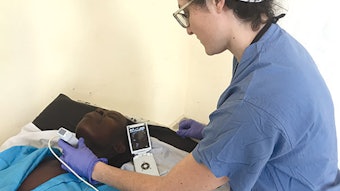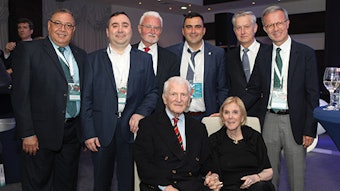Kids ENT Health Month: Ankyloglossia
Ankyloglossia, also known as “tongue-tie,” is an anomaly in which there is restricted tongue movement due to a short or thickened lingual frenulum or a highly attached genioglossus muscle. Despite the lack of consensus on diagnostic criteria, there has been a steady increase over the last 20 years in the diagnosis of ankyloglossia, as well as in lingual frenotomy procedures.
Robert H. Chun, MD, Chair, Pediatric Otolaryngology Committee
Ryan H. Belcher, MD, Member, Pediatric Otolaryngology Committee
Rose J. Eapen, MD, Member, Pediatric Otolaryngology and Media and PR Committees
Ankyloglossia, also known as “tongue-tie,” is an anomaly in which there is restricted tongue movement due to a short or thickened lingual frenulum or a highly attached genioglossus muscle. Despite the lack of consensus on diagnostic criteria, there has been a steady increase over the last 20 years in the diagnosis of ankyloglossia, as well as in lingual frenotomy procedures. This trend has been observed in both the Medicaid and in the private insurance populations. The steady increase has been attributed to a national and international effort to promote breastfeeding as well as knowledge of the role ankyloglossia is thought to play in hindering successful breastfeeding.1

There is a reported incidence of 25-80 percent of breastfeeding difficulty in infants with ankyloglossia.2 Due to the tongue’s restriction of mobility, infants are unable to extend their tongues over the gum line to form a proper seal and instead use their jaws to keep the breast in the mouth. This results in ineffective latch, maternal breast pain, poor milk supply, refusal of the breast, and failure to thrive.3
Ankyloglossia has also been implicated as a contributor to other feeding difficulties such as bottle-feeding, deglutition, and licking foods. It has also been purported to be responsible for difficulty playing wind instruments, oral hygiene, kissing, and drooling. It can reduce self-esteem or be a contributor in psychological issues for older patients.4
Although ankyloglossia can contribute to difficulties with feeding, children often can have other comorbidities such as hypotonia, oral motor discoordination, or laryngomalacia that can cause or contribute to their dysphagia.
Managing the goals and expectations of the family in these instances is often a delicate conversation as conservative measures and/or a frenotomy alone most likely will not resolve the feeding difficulty.
Surgical intervention/treatment
Indications for surgical intervention for ankyloglossia remain controversial. There is variation among clinicians in the role ankyloglossia plays in breastfeeding difficulty. One study showed 10 percent of pediatricians, 30 percent of otolaryngologists, and 69 percent of lactation consultants said that ankyloglossia frequently caused breastfeeding problems.5 These attitudes and beliefs can affect the referral patterns to the otolaryngologist for surgical intervention. A recent systematic review of the literature concerning treatment of ankyloglossia and breastfeeding outcomes did show evidence that suggests frenotomy may be associated with improved breastfeeding as reported by mothers.3 It should be noted that research is lacking on nonsurgical interventions for ankyloglossia and on the mid- to long-term breastfeeding outcomes among infants that had a frenotomy.3
Traditionally, local anesthesia offered a limited duration of benefit. Newer approved agents, such as liposomal bupivacaine that lasts 96 hours, are changing this paradigm and can be employed after different procedures in the head and neck. While epidural analgesia is not feasible for head and neck surgery, regional nerve blocks using long-acting local anesthetics can be performed.
Postoperatively, multiple non-Frenotomy is the most common surgery to treat ankyloglossia if conservative measures are not sufficient. This is performed by “clipping” the lingual frenulum and can often be performed without local anesthesia in the office setting with minimal bleeding. Some of the potential adverse effects include bleeding, pain, scar formation, and damage to the surrounding structures if not performed carefully.
The infant may feed immediately after the procedure. A frenotomy may need to be repeated if scarring occurs tethering the tongue. Alternatively, frenuloplasty may be performed. This procedure requires general anesthesia and involves one or multiple Z-plasties to release the frenum closed with sutures. If a revision surgery be considered, especially one requiring general anesthesia, you should ensure that there are no unidentified causes for the feeding difficulty or dysphagia.
Future directions
The majority of literature surrounding surgical management of ankyloglossia is concentrated on breastfeeding difficulty and outcomes. Strong scientific evidence and data concerning outcomes for frenotomy for issues outside of breastfeeding difficulty is limited. A systematic review looked at studies that evaluated all of the available literature on the treatment outcomes for ankyloglossia for medium- to long-term speech concerns, feeding processes other than breastfeeding, and social impact. This study found a deficiency of comparative data, against a backdrop of inadequate natural history data related to ankyloglossia.4
There are a multitude of other aspects of ankyloglossia that are yet to be studied thoroughly or to have strong evidence in either direction. Some of those aspects include
- How do comorbidities affect frenotomy outcomes?
- Does the type of tongue tie matter for outcomes?
- Do surgical revisions help?
- And other helpful questions that could assist feeding teams and physicians in management of these patients.
This emphasizes the need for quality prospective research to be performed in the future.
The American Academy of Otolaryngology–Head and Neck Surgery Foundation is convening a clinical consensus statement workgroup for ankyloglossia in 2019. Although it will not provide specific recommendations, a clinical consensus statement will reflect the opinions and practice from experts for the management or treatment of patients.
Bibliography:
- Walsh J, Links A, Boss E, Tunkel D. Ankyloglossia and lingual frenotomy: national trends in inpatient diagnosis and management in the United States, 1997-2012. Otolaryngology–head and neck surgery : official journal of American Academy of Otolaryngology-Head and Neck Surgery. 2017;156(4):735-740.
- Suter VG, Bornstein MM. Ankyloglossia: facts and myths in diagnosis and treament. J Periodontal. 2009;80(8):1204-1219.
- Francis DO, Krishnaswami S, McPheeters M. Treatment of ankyloglossia and breastfeeding outcomes: a systematic review. Pediatrics. 2015;135(6):31458-e31466.
- Chinnadurai S, Francis DO, Epstein RA, Morad A, Kohanim S, McPheeters M. Treatment of ankyloglossia for reasons other than breastfeeding: a systematic review. Pediatrics. 2015;135(e1467-e1474).
- Messner AH, Lalakea ML. Ankyloglossia: controversies in management. International journal of pediatric otorhinolaryngology. 2000;54(2-3):123-131.













